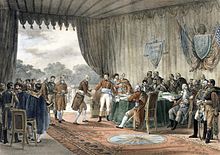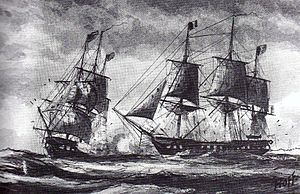Quasi-war
| date | 1798-1800 |
|---|---|
| place | Atlantic Ocean , Caribbean , Indian Ocean , Mediterranean |
| output | Mortefontaine Treaty : end of the privateer attacks on US ships, neutrality of the USA, abandonment of France |
| Parties to the conflict | |
|---|---|
| Commander | |
|
|
|
| Troop strength | |
|
54 ships : 18 frigates 4 sloops 2 briggs 3 schooners 5,700 sailors 365 privateers |
Unknown |
| losses | |
|
20 dead |
Some buccaneers captured |

The quasi-war ( French quasi-guerre , English quasi-war ) was an unexplained war between France and the United States between 1798 and 1800 , which was fought exclusively at sea (Atlantic Ocean, Caribbean Sea, Indian Ocean and the Mediterranean). In the United States, the conflict is sometimes called Unexplained war with France ( Undeclared War With France ), the Pirate Wars or the Half-War called.
Occasion and course
In 1778 the United States and France signed an alliance treaty to deepen their relations, in accordance with France's aid to the United States during the War of Independence against Great Britain . As part of this alliance, France, then under the rule of the monarch Louis XVI. , sizeable loans to the United States. After the French Revolution , the United States refused to repay its debts and revoked its agreements with France. They argued that the agreement with the French monarchy had been made, thus annulling their obligations after the regime change in France. Meanwhile, on November 19, 1794, the United States signed the Jay Treaty with Great Britain, which was directed against French privateers . In the face of increasing piracy in the Mediterranean and looting by privateers of revolutionary France , the United States Congress had previously seen itself compelled to build a navy to protect the growing sea trade.
In 1797, French demands on an American delegation sparked the so-called XYZ affair . The quasi-war began on July 7, 1798, when the United States Congress repealed treaties with France. US Navy squadrons ran out and attacked French privateers.
Captain Thomas Truxtun's insistence on the highest standards of training for the ship's crews paid off for the Americans when the frigate USS Constellation took two victories against French warships . Eight ships (one sloop , five schooners and two brigs ) operated along the southern coast of the United States and along the West Indies . The two briggs and two of the schooners carried 14 cannons and 70 crew members each . The sloop and the remaining schooners each had ten cannons and 34 crew members. Of the 22 prizes the United States hijacked between 1798 and 1799, 18 were hijacked by solo vehicles. Customs cruisers also helped capture two prizes. The customs cruiser USRC Pickering managed to capture ten prizes on two trips to the West Indies. One of the prizes had a crew of 250 men (three times as many as the Pickering ), carried 19 guns and weighed 150 pounds broadside , while the USRC Pickering had only 14 guns with a broadside weight of 56 pounds (25 kilograms) would have.
The quasi-war ended with the Treaty of Mortefontaine ( Convention of 1800 ).
literature
- William G. Anderson: John Adams, the Navy, and the Quasi-War with France . In: American Neptune , 30 : 117-132 (1970), ISSN 0003-0155 .
- Ulane Bonnel: La France, les Etats-Unis et la guerre de course (1797-1815) . Nouvelles Éditions latines, Paris 1961 (also dissertation, University of Paris 1960).
- Alexander De Conde: The Quasi-War. The Politics and Diplomacy of the Undeclared War with France, 1797-1801 . Scribner, New York 1966.
- Peter P. Hill: Prologue to the Quasi-War. Stresses in Franco-American Commercial Relations, 1793–1796. UMI, Ann Arbor, Mich. 1977.
- Gardner Weld Allen: Our Naval War with France . Archon Books, Hamden, Conn. 1967 (unchanged reprint of the Boston 1909 edition; digitized at the Internet Archive ).
Individual evidence
- ↑ America's First Limited War , Lieutenant Colonel Gregory E. Fehlings, US Army Reserve
-
↑ Text:Wikisource: en: Convention of 1800 (Treaty of Mortefontaine) - sources and full texts
- ↑ Summary in: Journal of Modern History , Vol. 49 (1977), pp. 1039-1069, ISSN 0022-2801

